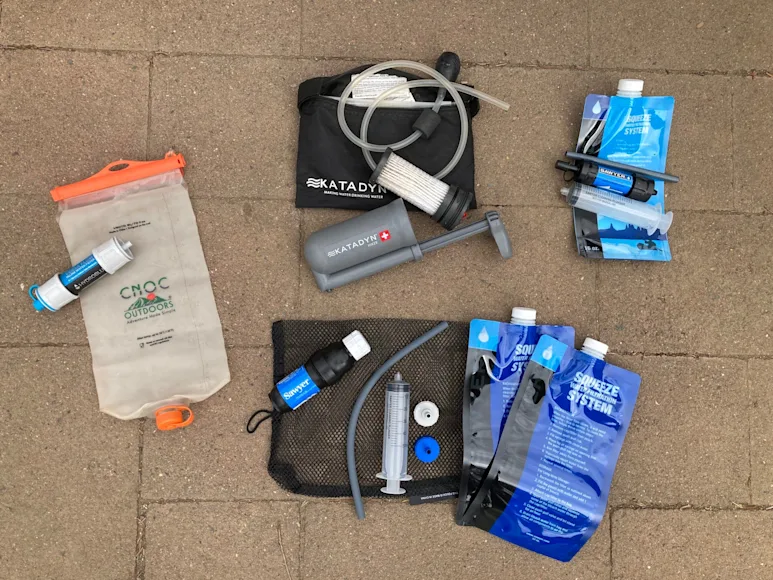_We may earn revenue from the products available on this page and participate in affiliate programs. Learn more ›
_
Best Overall

Sawyer Squeeze
Best Gravity Filter System

CNOC Outdoors Vecto and Versa Flow
Best Lightweight

Katadyn BeFree
When hiking in the backcountry, you need a good backpacking water filter to ensure access to safe, clean water. A functional water filter (and often a water purifier
, too) can’t be missed on a packing list. However, it takes time and research to pick the right one for you, with such a variety of styles and brands available.
The main difference between a water purifier and a water filter is that a filter is designed to remove waterborne bacteria and protozoa, while a purifier removes all microbes including viruses. While both can be beneficial, water purifiers tend to be more of a concern when traveling abroad versus in the North American backcountry. For this review, we focused only on the best backpacking water filters that have an optimized lifespan, are easy to use, and are compact enough to take with you on the trail.
Best Overall: Sawyer Squeeze
Best Lightweight: Katadyn BeFree
Best Budget: Sawyer Squeeze Mini
Best Gravity Filter System: CNOC Outdoors Vecto and Versa Flow
Best Pump Filter: MSR Guardian
Best Bottle Filter: Grayl GeoPress Bottle
Best Squeeze Filter: Platypus Quickdraw
Best Straw Filter: Lifestraw
How We Picked the Best Backpacking Water Filters
The best backpacking water filters must be portable, functional, and suited to your backcountry needs. The region, time of year, and length of trip can all play a role in the type of filter you may choose. In putting together our top picks, we took all of that and more into account. Although I personally have my favorite and go-to water filtration system, all the water filters went through the same process to ensure we only included the highest-performing options on the market. Once chosen, they were assigned an appropriate category.
Primary considerations in choosing the best backpacking water filter:
Portability: What is the size and weight of the entire filtering system? Is it small and compact enough to bring with backpacking? Are there a lot of parts that are easy to lose?
Ease of Filtration: How easy is it to filter the water through the system? How long does it take to filter the water?
Water Quality: What exactly does the water filter out? How is the water quality once filtered?
Maintenance: Is it easy to keep the filter clean? How long does the filter last? How many liters of water can it filter in its lifetime?
Durability: What is the lifespan of all filter components? Is there a return or repair policy if components break or malfunction? What is the warranty on the products?
Whenever possible, we test products for review. When products are not available for testing during the writing of the review, we rely on firsthand experience from other industry experts along with additional knowledge about industry practices, manufacturing processes, and interviews with companies. Products are subject to change, and reviews are updated periodically as more gear is tested for longevity and durability.
Best Backpacking Water Filters: Reviews and Recommendations
Best Overall: Sawyer Squeeze
Best Overall

Specs
Type of Filter: Squeeze
Liters Per Lifetime: 378,541 L / 100,000 gal
Weight: 5.7 oz
Effective Against: Particulates, bacteria, protozoa
Pros
Lightweight and portable
Straightforward and easy to use
Affordable price
Lifetime guarantee
Filter fits on a standard Smartwater bottle
Cons
Bags are not the most durable
Regular filter cleaning is necessary
It’s no surprise that our top pick is the Sawyer Squeeze. A classic icon in the world of backpacking, it’s an affordable, adaptable, and versatile water filter option for individual hikers. It’s hard to beat the packability and functionality. The filter is long-lasting and, if kept clean, has an excellent flow rate for its entire lifespan. Still, even if you lose or break the bags (they aren’t the most durable), the filter is adaptable to other water containers, like the popular ultralight option of using a Smartwater bottle.
To use the Sawyer Squeeze water filter, all you have to do is fill the squeeze pouch with water, attach the filter to the pouch, and drink directly from the removable flip-top cap or squeeze the water into another bottle. This filter is also compatible with Sawyer hydration packs, allowing you to attach the filter to the water reservoir so it filters as you drink. If you are on a long trek, bring the backflushing syringe to ensure the flow rate stays up to par. Otherwise, the filter will be backed up, and it will be hard to use. The Sawyer Squeeze filter is an excellent system for individuals entering the backcountry. It is reliable, lightweight, easy to use, and highly effective at removing bacteria, protozoa, and microplastics.
One downside? The filter comes with so many parts and pieces that it can be easy to lose them when you’re out on the trail.
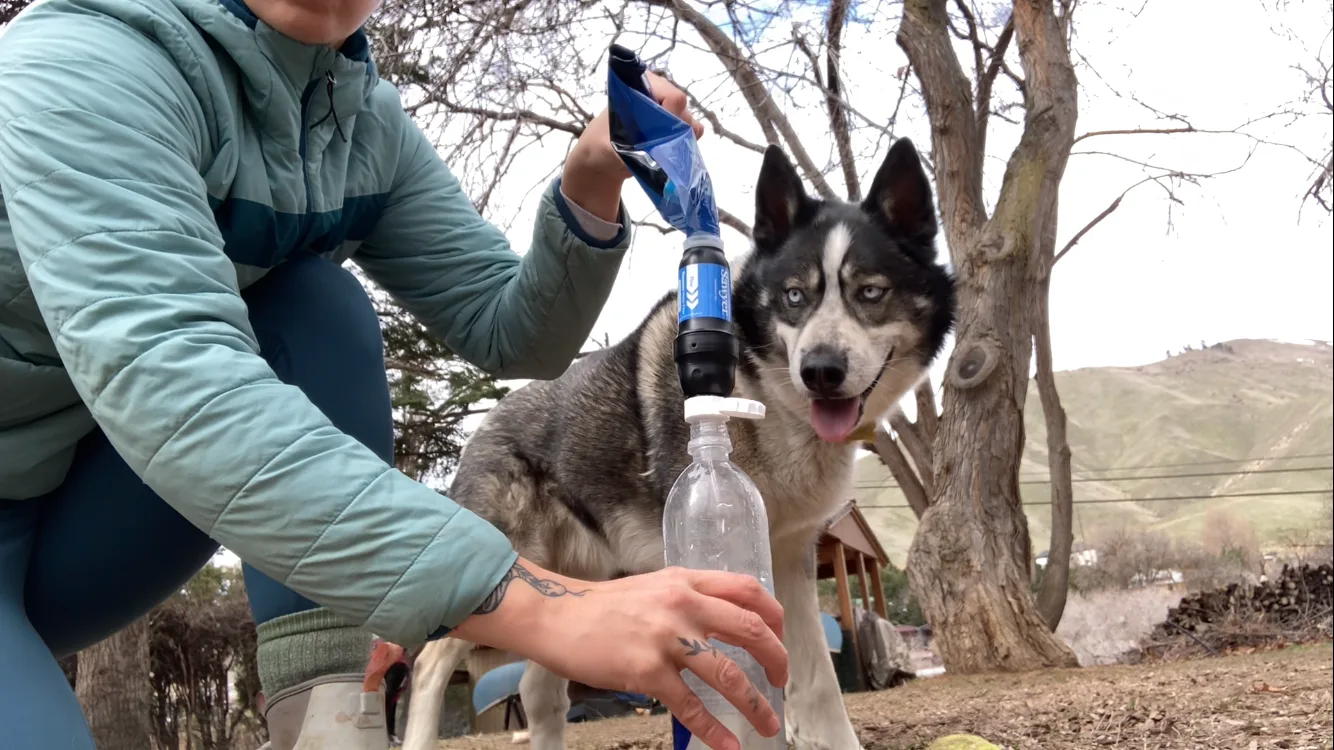
The Sawyer Squeeze is quick and easy to use. There was enough pressure to filter water by squeezing the bag with one hand and holding the secondary bottle with the other.
Best Gravity Filter System: CNOC Outdoors Vecto and Versa Flow
Best Gravity Filter System

Specs
Type of Filter: Gravity, squeeze, straw
Liters Per Lifetime: 378,541 L / 100,000 gal
Weight: 2 oz (filter), 1-3 oz (per bag)
Effective Against: Particulates, bacteria, protozoa
Pros
Lightweight system
Durable CNOC bags
Versatile filter application
Clear window to see when cleaning is needed
Affordable price
Cons
Needs to be backflushed often for best flow rate
The Hydra Blue Versa Flow Filter is a standalone water filter option that is versatile in and of itself. You can use it with various bags and in several ways to filter water. My favorite way to use it is as a gravity filter, but it also works as a squeeze or straw filter when needed. When used as a gravity filter, we recommend pairing it with the CNOC Outdoor Vecto bags
. With just one bag, you have a very lightweight filter kit that can still act as a gravity filter system or simply as a squeeze filter. With two bags, fill one bag with dirty water, attach the filter with a secondary bag, hang the system, and let gravity do the work. Within a few minutes, you have clean water in a portable container.
One issue we’ve found with other filter systems, like Sawyer, is that the filter itself is amazing, but the bags are less durable and long-lasting than they need for outdoor use. That’s not the case for these. The CNOC Outdoors bags are available in 1L, 2L, or 3L sizes, and with the filtration speed and bag sizes, this can be a functional filtering system for groups if you’re willing to filter water a few times. The bags in the image below are 2L bags (2.8 oz), and all of the bags attach to any filter with a 28 mm thread (Sawyer Squeeze and Mini and the LifeStraw Flex). The bags have a breaking point of 220 lbs but still have the potential to be punctured or damaged.
After using this filter for 2+ years, I haven’t experienced any issues with bags being damaged or compromised. The only negative I’ve found is that they’re prone to discoloration with specific exposure to UV and water chemicals because they are made from a BPA, BPS, and BPF-free TPU (Thermoplastic Polyurethane) material. Fortunately, the color changes do not affect the functionality or compromise the water quality, so the bags are safe to continue to use.

Hydra Blue Versa Flow Filter with the CNOC Outdoors Vecto Water Bags
Best Pump Filter: MSR Guardian
Best Pump Filter
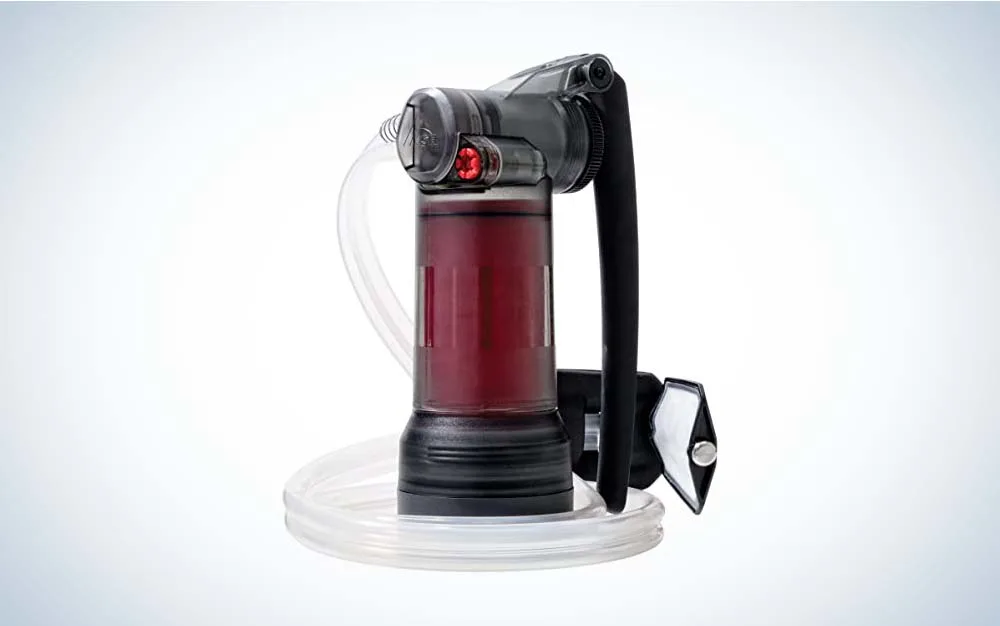
Specs
Type of Filter: Hand pump
Liters Per Lifetime: 10,000 L / 2642 gal
Weight: 2.19 lbs
Effective Against: Viruses, bacteria, protozoa, and particulate
Pros
Also filters out viruses
Very fast flow rate
Durable construction
Works well in even cold weather conditions
Cons
Overkill for most hikers, especially in the North American backcountry
Expensive
The best hand pump water filter we’ve found is the MSR Guardian. For the standard backpacker and most ventures in the North American backcountry, this filter may be a bit overkill but the size, price, and capabilities of filtering out viruses make this an excellent investment for international travel. It has a fast flow rate and is self-cleaning, so it’s great for groups and for preventing additional maintenance when on the trail. The self-cleaning feature helps maintain the fast filtration speed (1L in 40 seconds) and ensures the filter doesn’t clog, even when filtering water with a high sediment level (turbid water).
The hollow fiber filter has a pore size of 0.02 microns and can filter out viruses, bacteria, protozoa, and particulate. The only thing that would make this filter better is if it had activated carbon in the filter also to remove chemicals from the water. It’s heavy in comparison to other filter options, but it’s very durable. It can withstand moderate falls onto hard surfaces and rocks and still works even in freezing temperatures. It comes with a convenient carrying case, which we recommend for keeping all the pieces together. While this filter is a bit bulky, it’s very effective and ideal for backpackers who frequently travel internationally.
Best Bottle Filter: Grayl GeoPress Bottle
Best Bottle Filter
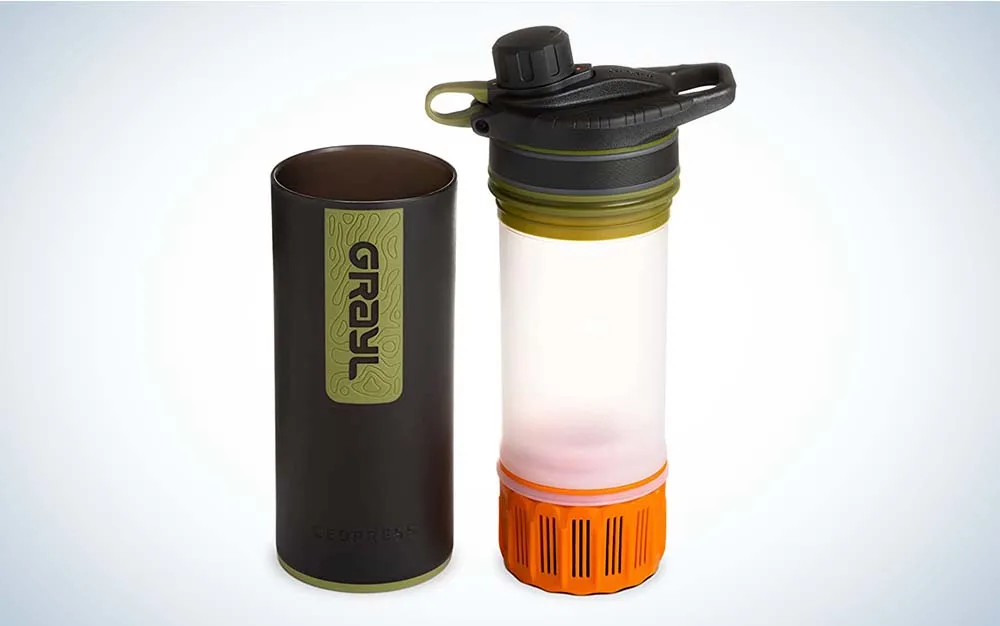
Specs
Type of Filter: Bottle press
Liters Per Lifetime: 250 L / 65 gal
Weight: 15.9 oz
Effective Against: Viruses, bacteria, protozoa, particulates, chemicals, and heavy metals
Pros
Quick and easy filter process
Highly effective filter
Easily replaceable filter
Great for backcountry and travel
Cons
Short filter lifespan (350 presses)
Weight
Many straw and squeeze filter brands on the market also sell versions with the filter built into a water bottle. These applications of those filters are quite practical and were considered for this category, but the overall best water bottle filter we found is the Grayl GeoPress Bottle. Unlike the straw filters that use suction to pull the water through the filtration process, this bottle requires you to fill it up and press the filter through the water. You have clean, ready-to-drink water in just eight seconds and one push.
Like other filters on our list, the Grayl GeoPress removes bacteria, protozoa, and particulates, but it also removes viruses, chemicals, and heavy metals. Because of the presence of activated charcoal in the filter, it also eliminates flavors and orders from the water. If you’re looking for a water bottle filter that you can bring in the backcountry and for international travel, we recommend this one because of the high level of water filtration available.
While the filtration process is quick and easy, the filter does not last as long as other options (replace after 350 presses). Luckily, the filter is replaceable so that the bottle can function for quite some time.
Best Squeeze Filter: Platypus Quickdraw
Best Squeeze Filter
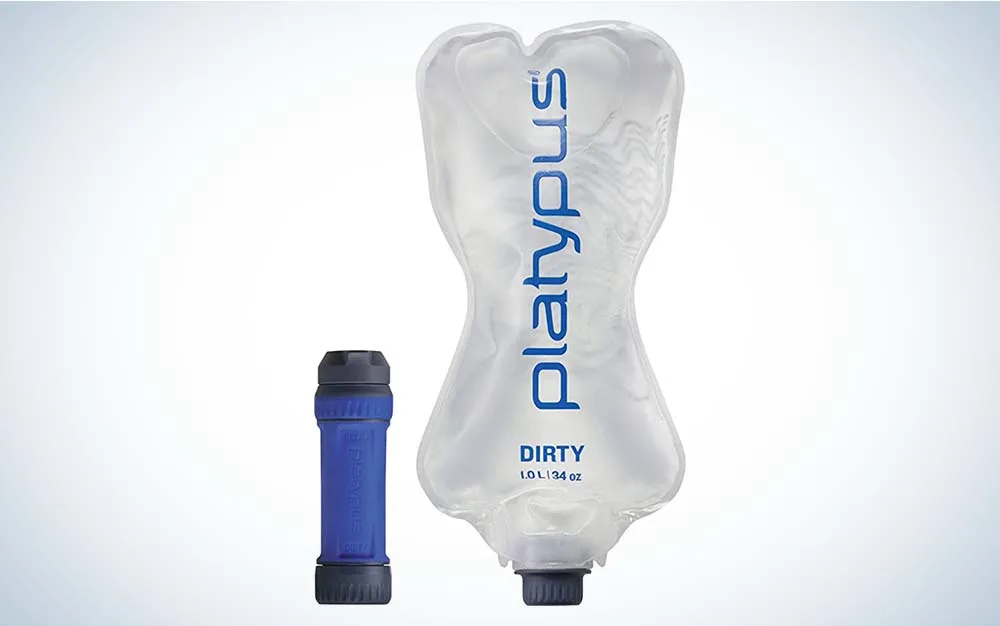
Specs
Type of Filter: Squeeze
Liters Per Lifetime: 1,000 L / 264 gal
Weight: 3.3 oz
Effective Against: Bacteria, protozoa, and particulates
Pros
Tool-free backflush cleaning
Thread attaches to Smartwater bottles
Filters 3L per minute
Fast flow rate
Easy-to-understand filtering system
Cons
Not the most durable or versatile option
No known bag replacement by the company
If the Sawyer Squeeze contains too many parts, we recommend the Platypus Quickdraw as an alternative. While we found that this water filtering system is not as durable as the Sawyer filter or the Versa Flow, it’s still worth considering if you want something simple and to the point. The Platypus bags are more durable and more functional than the Sawyer bags, but harder to fill than the CNOC Outdoors Vecto bags. The thread on the filter itself is versatile enough to fit on Smartwater bottles and other filter bags.
The filter is a hollow fiber membrane that filters out bacteria, protozoa, and most particulates. The thread on the filter is part of the system that may break over time, but if needed, the filter is sold separately. If the bag is damaged, I am not sure if they sell dirty water bags separate from the filter, but the filter is compatible with other water containers.
To clean the filter, you do not need additional tools, which is a big sell for many backpackers. Platypus utilizes a shake clean system, but it isn’t necessarily the most effective clean. It works in a pinch on the trail if the filter is really clogged, but a system like Sawyer’s is ideal for a more thorough clean. This filter does the trick, but it isn’t my favorite. If you want a sweet, simple, and relatively affordable backpacking system, we still recommend it. It is lightweight and has a straightforward filtering system.
Best Straw Filter: Lifestraw
Best Straw Filter
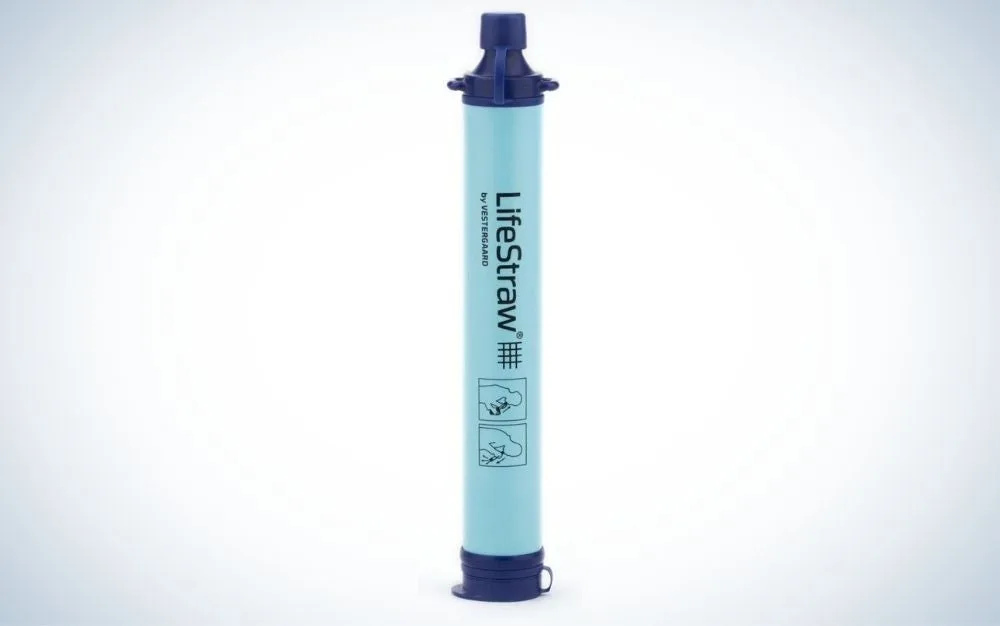
Specs
Type of Filter: Straw
Liters Per Lifetime: 4,000 L / 1,000 gal
Weight: 2 oz
Effective Against: Bacteria, parasites, and particulates
Pros
Lightweight and highly packable
Great for backpacking and emergency kits
Easy to use
Available in multi-packs
Affordable price
Cons
Can’t filter large amounts of water at a time
Can be difficult for some users to filter water while drinking
The LifeStraw filter is an innovative and straightforward water filter design. LifeStraw has two amazing straw options: the original (pictured above) and the Peak Series Personal Water Filter
. We like both options for backpacking and emergency kits because they are compact and easy to use. You can drink directly from a water source by sticking the intake end into the water and then using the other end as a straw to use suction to draw water through the filter. Since leaning down into a lake or a river isn’t the most practical in all applications, you can also fill a water container and use the filter as you would a straw to drink the water.
The Peak Series offers some features beyond the original that may make it more favorable for your backpacking adventures. It has an enhanced microfilter performance for a better flow rate and a lower likelihood of clogging from sediment. The premium materials mean a more durable and leak-proof design, and it is more versatile overall. The built-in gravity hose attachment and universal threading allow you to attach it to squeeze bottles for easy drinking on the go.
As an individual water filter system, LifeStraw is effective regardless of the option you choose. The main downside we found is that it doesn’t have the same capability to filter large quantities of water at one time. LifeStraw sells a variety of other filter options that include water bottles and some larger filter systems that can filter more water at one time. All straw water filters have limited application and can be awkward to use, but they’re effective. If you like the LifeStraw concept, our favorite filter option they produce is the LifeStraw Flex
which functions as a water bottle or a squeeze filter.
Best Lightweight: Katadyn BeFree
Best Lightweight

Specs
Type of Filter: Squeeze, water bottle
Liters Per Lifetime: 1,000 L / 264 gal
Weight: 2.1 oz
Effective Against: Bacteria, protozoa, and particulates
Pros
Lightweight and portable
Straightforward filter design
Collapsible bottle
Can drink directly from the filter
Cons
Small
If you’re looking for a lightweight filter perfect for day hikes and other domestic travel applications, the Katadyn BeFree is a great option. If you are a long-distance trail runner, we favor this option because of the portable design. While the water container is small, the filter and bottle are easy to use. All you need to do is fill the water bottle, and then drink directly from the filter, which doubles as the mouth of the bottle. Alternatively, this can function as a squeeze filter to fill other water containers.
Overall, the functionality is ideal, and it has a great flow rate when filtering as a squeeze system. However, the small size makes it somewhat limited in application, and the collapsible bottle has a questionable level of durability. It is a decent value for the price, and depending on how you use it, it is an excellent water filtration option. If you are an ultralight backpacker or know you’ll cross several water sources on a trip, you’ll likely favor this filter over other, more complicated options.
Best Budget: Sawyer Squeeze Mini
Best Budget
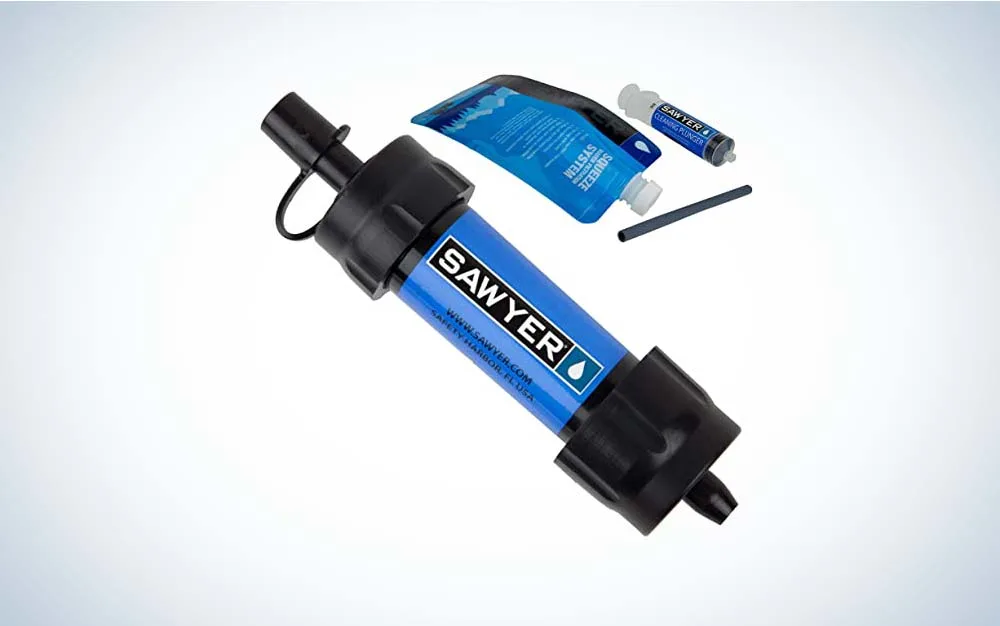
Specs
Type of Filter: Squeeze
Liters Per Lifetime: 378,541 L / 100,000 gal
Weight: 3.5 oz
Effective Against: Bacteria, protozoa, and particulates
Pros
Lightweight and portable
Affordable price
Verastile system
Long filter lifespan
Straightforward to use
Cons
Small bag makes it harder to filter larger quantities of water
Bag durability could be better
One of the most compact and affordable water filters with a high performance level is the Sawyer Mini filter. It’s smaller and more lightweight than the Sawyer Squeeze, but it still provides the same filtering capabilities and water quality. The system has a small filter, a squeeze water bag, a straw, and a plunger/syringe to clean the filter. This filter functions the same as standard squeeze filters: Fill the water bag provided and squeeze the water to apply enough pressure to move the water through the filter.
The quality of the filter itself is ideal, and it lasts up to 100,000 gallons of water. The best way to get close to that lifespan for the filter is to clean it regularly and ensure it never freezes. If you’re hiking in cold temperatures, hike with the filter close to your body to prevent it from freezing. Freezing may damage the filtering capabilities. If you want a lightweight and reliable filter, then Sawyer is an easy choice. It has a straightforward filtering process, is easy to maintain, and is highly portable (not to mention one of the most affordable options).

Sawyer Mini (left) compared to the Sawyer Squeeze (right)
What to Consider When Choosing a Backpacking Water Filter
Intended Use
Backpacking water filters are meant for use in backcountry settings where clean drinking water is not readily available. Drinking from natural water sources like rivers, lakes, or streams poses risks of exposure to bacteria and other contaminants that can make us sick. Using a water filter provides a safe way to collect water for drinking. The type of water filter you choose largely depends on your comfort level with different water filter and purification methods, the amount of weight you’d like to carry, how much water you need to filter, and the water filtering speed.
Knowing the types of water sources on the trail gives you a good idea of the kind of water filter that may best suit your needs. Some water filters provide storage for clean water so you can carry it from place to place. If you are crossing several water sources throughout the hike, a small water bottle filter may be the best choice. Researching the type of water source and the distance between sources provides the necessary information for choosing the best backpacking water filter for your hike.
Consider packability and ease of use, too. For instance, gravity filters are one of the least labor-intensive water filtering methods, but they can be more time-consuming than squeeze or pump filters. Pump filters tend to have more parts and are harder to repair if something goes wrong than other options. Other factors, such as the group size and water filtration quality, may also come into play.
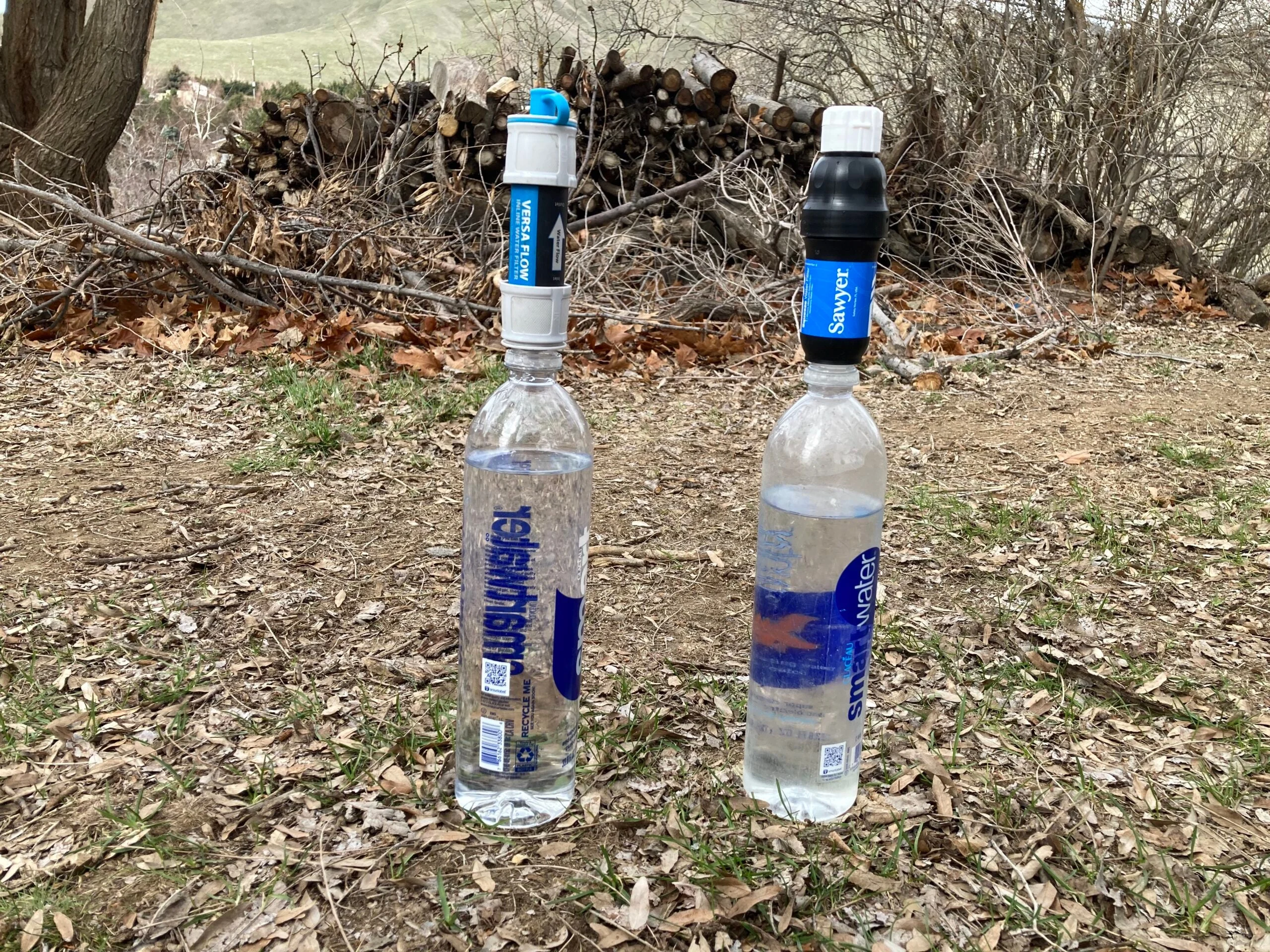
Having a filter that can attach to several water containers makes it more versatile and adaptive. Pictured are the Versa Flow (left) and Sawyer Squeeze (right) attached to smartwater bottles.
Type of Filter
The type of water filter could mean how the filter functions to clean the water. Some examples include a straw filter, a pump filter, a gravity filter, or a squeeze filter. Each of those types of water filters has varying benefits.
Types of portable water filters:
Gravity: Gravity water filters utilize one container to hold dirty water and use gravity to move the water through the filter. Some gravity filter systems have two bags, one for dirty water and a second for clean water. Other methods only have a dirty water bag, and the filter drips water into a bottle or other container of your choice.
Pump: Pump filters are not as convenient as other filtering methods because they require manual pumping to move the dirty water through the filter. That said, pump filters are good for groups or filling up larger water containers. Usually, the hose inserts directly into the water, you manually pump the water to push it through the filter, and the clean water flows through the other tube into a new container.
Straw: Straw filters are a portable filter option, and like a drinking straw, all you have to do is put the straw filter into the water and drink. The suction of your drinking moves the water through the filter to clean it. These don’t filter much water at a time, but they work well for travel or emergencies.
Bottle: Water bottle filters are ideal for travel and backpacking as they include a water canister with a filter built directly into it. These bottles often use the same type of straw filter discussed above, but they come in a reusable easy-to-carry container that makes it easier to drink from on the go.
Squeeze: Similar to a bottle and gravity filter, a squeeze filter has a filter attached to a water container. To use a squeeze filter, fill the water container with dirty water, attach the filter, and then squeeze the water into a clean water bottle. You can also drink directly from the filter on squeeze bottles which combine the idea of a squeeze filter and a water bottle.
The type of filter can determine how easy it is to use. For backpacking, squeeze, pump, and gravity filters are the most common because they can filter a large amount of water at a time for drinking, cooking, or washing. Squeeze filters offer a more lightweight filtering option, whereas gravity filters, in some cases, can be light but are easier to use when filtering large quantities of water. Pump filters are very effective and work well but are less popular because it is more labor-intensive to filter the water. It’s also worth considering if water storage is built into the filtering system or if you need to bring additional water storage for clean water.
Filter Media
The filter media also determines the type of filtering method and the effectiveness of cleaning specific contaminants. Some filters may contain activated carbon, which can remove things like pesticides, smells, and heavy metals.
Four types of filter media available include:
Fiberglass: Effective at removing particles, fiberglass filters are one of the most fragile filter media available. Made from 100% micro-fine borosilicate glass fibers, they have a high flow rate where sub-micron filtration is necessary. Fiberglass filters are commonly used to filter both liquid and air commercially.
Hollow Fiber: Made up of synthetic polymers to create a U-shape microtube that resembles a drinking straw (fibers), a hollow fiber filter works by moving water through the tiny holes or pores. All pores are uniform in size and only allow clean water to pass through, removing contaminants. The standard pore size of a hollow fiber filter is 0.2 microns, but they can be as small as 0.01 microns. The larger the pore size in a hollow fiber filter, the faster the flow rate, which makes them common for gravity or straw filters. Hollow fiber filters with smaller pore sizes, closer to 0.01 microns in size, require more pressure to move water through but have the benefit of addressing more advanced removal in some applications.
Ceramic: A natural, earthen material, ceramic filters are long-lasting and easy to clean. This is important because they get clogged up quickly, so you’ll be cleaning them often. Many ceramic filters also have a carbon core or an additional filtration media to remove chemicals more effectively.
Silica Depth: Using multiple levels of finely grained silica sand, these filters work by layering the sand from largest to finest. As the water moves through the layers, the sand filters out the particles and organisms, so only clean water results.
Many popular backpacking water filters utilize a hollow fiber filter media. Sawyer products, for example, utilize a hollow fiber filter with a 0.01 membrane pore size. Other filter brands, like MSR, may primarily use hollow fiber but also have some ceramic + carbon filter options.
Filtration Speed
The filtration speed or the filter’s flow rate is how fast dirty water flows through the filter out into clean, potable water. The micron size, pressure, and type of filter can all influence the speed of filtration. Some filters are nearly instantaneous, while others may take a few minutes. Pump, straw, and bottle filters provide the fastest filtration rates on average.
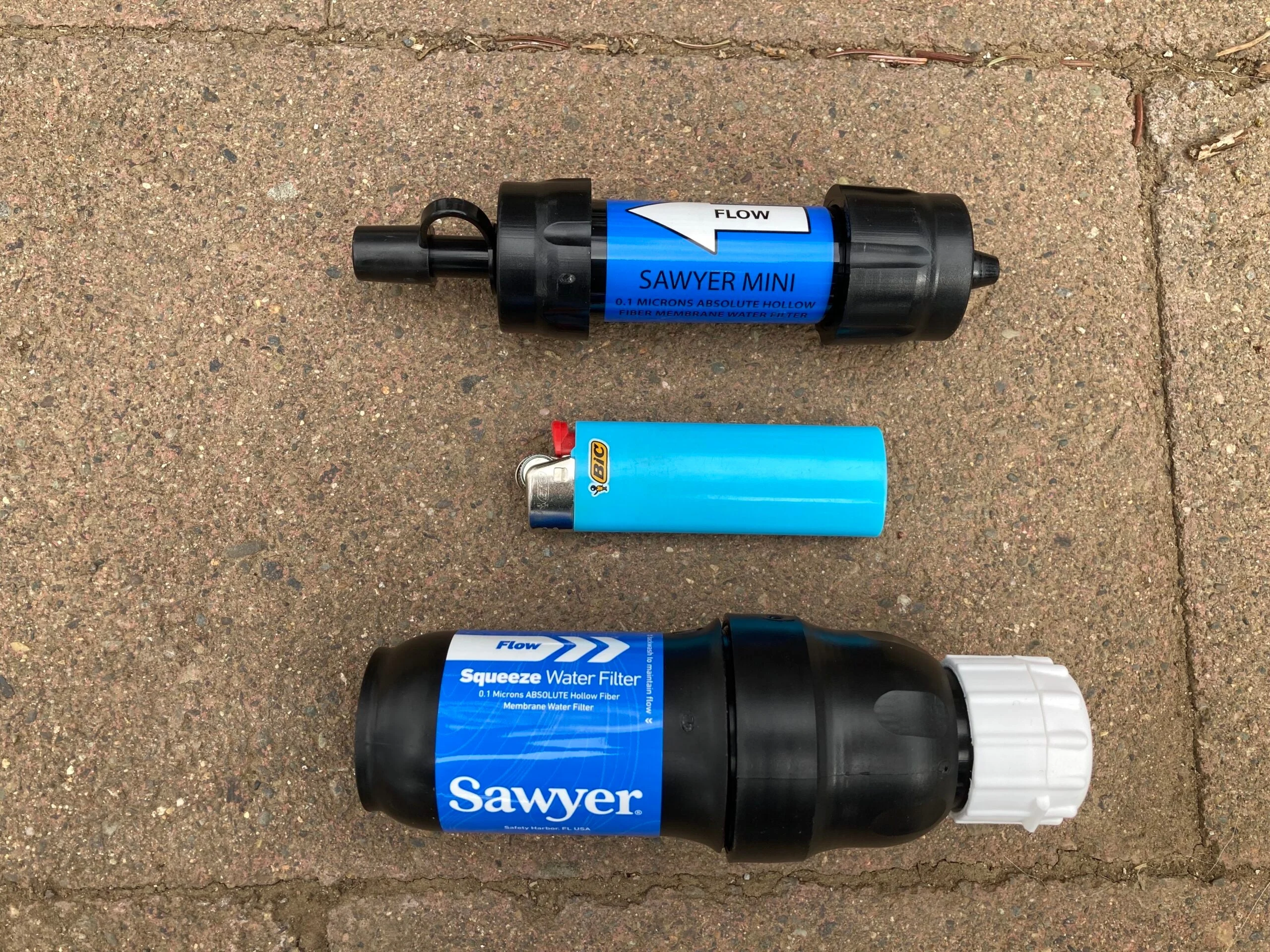
The flow rate of the filter can also be impacted by the filter size. Pictured is the Sawyer Mini (top) and the Sawyer Squeeze (bottom) next to a standard Bic lighter. The Sawyer Squeeze has a slightly faster filtration speed than the mini because it is a larger filter.
Gravity and squeeze filters may take a little longer, with gravity filters being the slowest. While they are slower, they are still very effective and one of the easiest to use overall. Gravity filters work well to filter a few gallons of water at a time, but it takes several minutes. The best way to use these is by filling them up at the start of a hiking break or while setting up camp. That way, the water is filtered and ready when you need it, but you can get other things done in the meantime.
Maintenance and Cleaning
Knowing how to clean and maintain your water filter will keep it in working order for the entire lifespan of the product. Over time, filters will start to get clogged and backed up by debris, dirt, and sediment. If your water filter is beginning to have a slower flow rate, it may need to be cleaned. Frequent and proper cleaning is the best way to preserve the filter’s effectiveness and prevent you from having to purchase a new one prematurely.
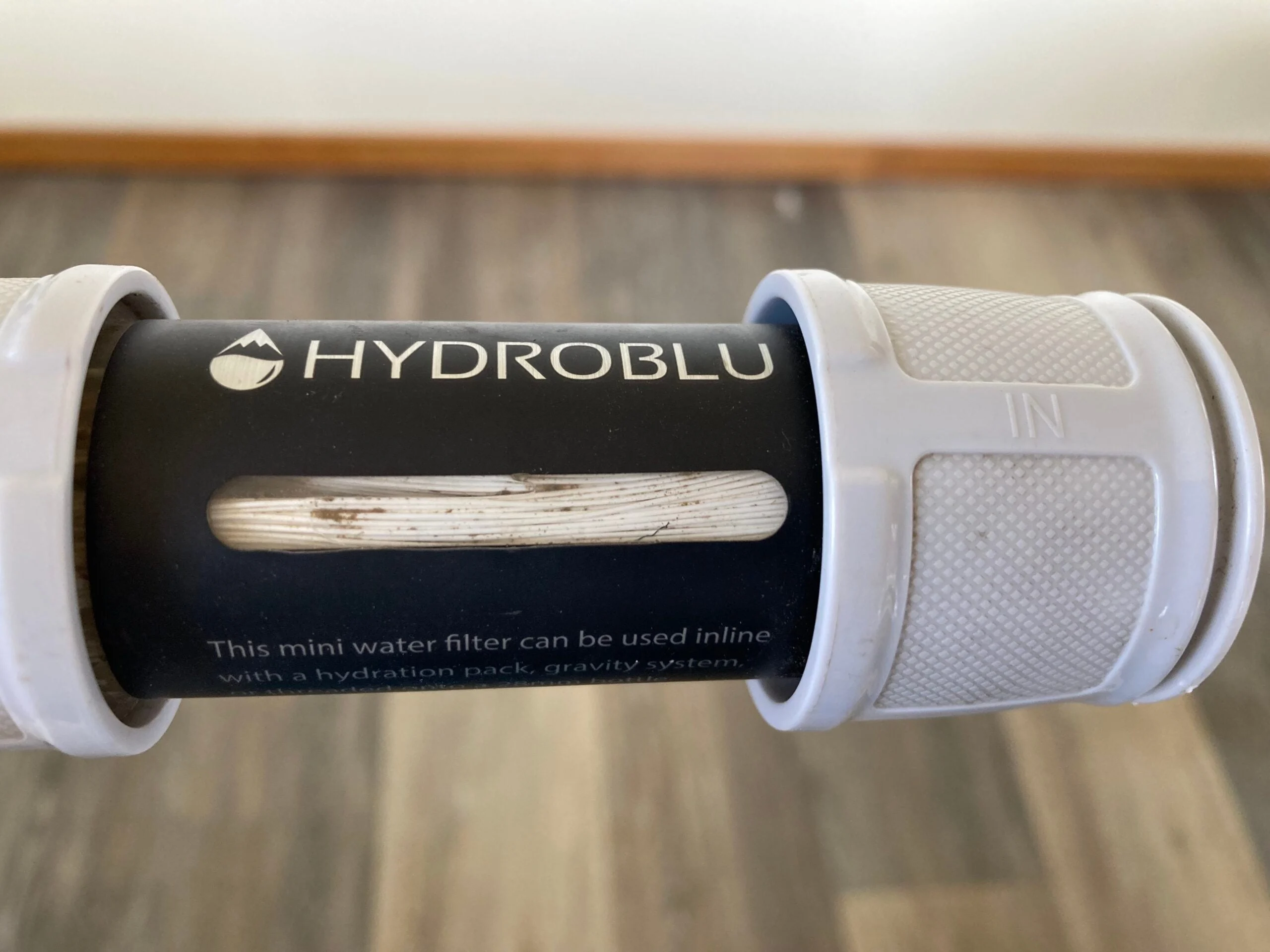
Some filters, like the Versa Flow, have a window to show when the filter needs to be cleaned. To clean the Versa Flow, all you need to do is run clean water in the opposite direction of the standard water flow.
How you clean the filter depends on the filter media and the manufacturer’s instructions. Most filter brands have specific instructions and even solutions or tools that come with the product to clean the filter. Popular filters like the Sawyer Squeeze are cleaned with a backflush method. Other filters with removable filter media may use a sanitizing solution and need to be rinsed under water. Pump filters often have you run a sanitizing solution through the filter and then rinse it afterward. Whatever the method, we recommend doing this at the end of the season after your last trip while the filter is still wet and easier to clean.
FAQs
Q: How do I choose a water filter for backpacking?
First, identify the intended use. Then narrow it down by evaluating the weight, size, flow rate of filtration, maintenance, and durability of the filter. Every filter has advantages and disadvantages, so knowing your preferences and comfort levels with the varying options will help you find the best backpacking water filter.
Q: What is the safest water filter for backpacking?
All the backpacking water filters on our list are considered safe for use in North America. Water-borne viruses are uncommon in the North American backcountry, which is why it is not a concern. Most water filters do not filter out viruses, so when traveling to foreign countries, a water filter and purifier may be necessary.
The only filters on our list that we recommend for international travel are the MSR Guardian and Grayl GeoPress since they can filter out viruses. Lifestraw also has a model capable of filtering out viruses: The LifeStraw Family
. The standard LifeStraw filters do not have the same capabilities as this water purification system.
Q: What kind of water filter do I need for backpacking?
To safely filter the water while backpacking in the backcountry of North America, any of the water filters on our list make the cut. These filters vary from pump filters to gravity filters or even straw filters. All of these filters have a micron size of 0.4 or less which ensures that they can effectively remove any parasites, bacteria, or other contaminants. Keep in mind that these water filters cannot remove any chemical or viral contaminants; to do that, a purification system, UV, or chemical treatment is necessary.
Q: How do I clean a backpacking water filter?
The type of filter you have determines how to clean it. Standard gravity or squeeze filters tend to be the easiest and most straightforward to clean because they typically don’t require removing any components. Some filters require backflushing, some you can take apart and clean, and others may need a sanitizing solution run through them. For more detailed information, read our Gear Rx column on the best ways to backflush and sanitize a water filter
.
Q: How long does a backpacking water filter last?
How long a backpacking filter lasts depends on the filter size and the liters it can filter in its lifetime. Larger filters generally last longer because they can filter larger quantities of water. Backpacking water filters will range from filtering 500-100000 gallons of water in their lifetime. Proper cleaning and maintenance of the filters help them last close to the expected lifespan. Still, if left unmaintained, filters can easily clog up, and even the best filters may only last about 300 gallons of water in those conditions.
Final Thoughts on the Best Backpacking Water Filters
Best Overall: Sawyer Squeeze
Best Gravity Filter System: CNOC Outdoors Vecto and Versa Flow
Best Pump Filter: MSR Guardian
Best Bottle Filter: Grayl GeoPress Bottle
Best Squeeze Filter: Platypus Quickdraw
Best Straw Filter: Lifestraw
Best Lightweight: Katadyn BeFree
Best Budget: Sawyer Squeeze Mini
The best backpacking water filters are not only portable, but they are also easy to use and have a decently long lifespan. There should be no questions about the durability of the water filters, and they need to effectively filter out bacteria, protozoa, parasites, and other contaminates commonly present in the North American backcountry. We chose the Sawyer Squeeze as the best overall filter for its affordability, effectiveness, and ease of use. All the other filters on our list are still excellent backcountry filtration options, but one may suit your backpacking needs more than another.
Why Trust Us
For more than 125 years, Field & Stream has been providing readers with honest and authentic coverage of outdoor gear. Our writers and editors eat, sleep, and breathe the outdoors, and that passion comes through in our product reviews. You can count on F&S to keep you up to date on the best new gear. And when we write about a product—whether it’s a bass lure or a backpack—we cover the good and the bad, so you know exactly what to expect before you decide to make a purchase.

